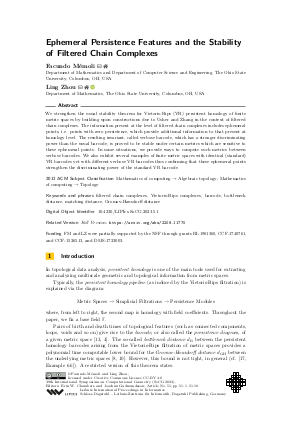Ephemeral Persistence Features and the Stability of Filtered Chain Complexes
Authors
Facundo Mémoli,
Ling Zhou 
-
Part of:
Volume:
39th International Symposium on Computational Geometry (SoCG 2023)
Part of: Series: Leibniz International Proceedings in Informatics (LIPIcs)
Part of: Conference: Symposium on Computational Geometry (SoCG) - License:
 Creative Commons Attribution 4.0 International license
Creative Commons Attribution 4.0 International license
- Publication Date: 2023-06-09
File

PDF
LIPIcs.SoCG.2023.51.pdf
- Filesize: 0.85 MB
- 18 pages
Document Identifiers
Related Versions
- Full Version https://arxiv.org/abs/2208.11770
Subject Classification
ACM Subject Classification
- Mathematics of computing → Algebraic topology
- Mathematics of computing → Topology
Keywords
- filtered chain complexes
- Vietoris-Rips complexes
- barcode
- bottleneck distance
- matching distance
- Gromov-Hausdorff distance
Metrics
- Access Statistics
-
Total Accesses (updated on a weekly basis)
0Document
0Metadata
Abstract
We strengthen the usual stability theorem for Vietoris-Rips (VR) persistent homology of finite metric spaces by building upon constructions due to Usher and Zhang in the context of filtered chain complexes. The information present at the level of filtered chain complexes includes ephemeral points, i.e. points with zero persistence, which provide additional information to that present at homology level. The resulting invariant, called verbose barcode, which has a stronger discriminating power than the usual barcode, is proved to be stable under certain metrics which are sensitive to these ephemeral points. In some situations, we provide ways to compute such metrics between verbose barcodes. We also exhibit several examples of finite metric spaces with identical (standard) VR barcodes yet with different verbose VR barcodes thus confirming that these ephemeral points strengthen the discriminating power of the standard VR barcode.
Cite As Get BibTex
Facundo Mémoli and Ling Zhou. Ephemeral Persistence Features and the Stability of Filtered Chain Complexes. In 39th International Symposium on Computational Geometry (SoCG 2023). Leibniz International Proceedings in Informatics (LIPIcs), Volume 258, pp. 51:1-51:18, Schloss Dagstuhl – Leibniz-Zentrum für Informatik (2023)
https://doi.org/10.4230/LIPIcs.SoCG.2023.51
BibTex
@InProceedings{memoli_et_al:LIPIcs.SoCG.2023.51,
author = {M\'{e}moli, Facundo and Zhou, Ling},
title = {{Ephemeral Persistence Features and the Stability of Filtered Chain Complexes}},
booktitle = {39th International Symposium on Computational Geometry (SoCG 2023)},
pages = {51:1--51:18},
series = {Leibniz International Proceedings in Informatics (LIPIcs)},
ISBN = {978-3-95977-273-0},
ISSN = {1868-8969},
year = {2023},
volume = {258},
editor = {Chambers, Erin W. and Gudmundsson, Joachim},
publisher = {Schloss Dagstuhl -- Leibniz-Zentrum f{\"u}r Informatik},
address = {Dagstuhl, Germany},
URL = {https://drops.dagstuhl.de/entities/document/10.4230/LIPIcs.SoCG.2023.51},
URN = {urn:nbn:de:0030-drops-179014},
doi = {10.4230/LIPIcs.SoCG.2023.51},
annote = {Keywords: filtered chain complexes, Vietoris-Rips complexes, barcode, bottleneck distance, matching distance, Gromov-Hausdorff distance}
}
Author Details
- Department of Mathematics and Department of Computer Science and Engineering, The Ohio State University, Columbus, OH, USA
Funding
FM and LZ were partially supported by the NSF through grants RI-1901360, CCF-1740761, and CCF-1526513, and DMS-1723003.
References
- Ulrich Bauer. Ripser. https://github.com/Ripser/ripser, 2016.
- Peter Bubenik and Jonathan A. Scott. Categorification of persistent homology. Discrete & Computational Geometry, 51(3):600-627, April 2014. URL: https://doi.org/10.1007/s00454-014-9573-x.
-
Dmitri Burago, IU D Burago, Yuri Burago, Sergei A Ivanov, and Sergei Ivanov. A course in metric geometry, volume 33. American Mathematical Soc., 2001.

-
Gunnar Carlsson. Topology and data. Bulletin of the American Mathematical Society, 46(2):255-308, 2009.

- Wojciech Chachólski, Barbara Giunti, and Claudia Landi. Invariants for tame parametrised chain complexes. Homology, Homotopy & Applications, 23(2):183-213, 2021. URL: https://doi.org/10.4310/HHA.2021.v23.n2.a11.
- Wojciech Chachólski, Barbara Giunti, Alvin Jin, and Claudia Landi. Decomposing filtered chain complexes: Geometry behind barcoding algorithms. Computational Geometry, 109:101938, 2023. URL: https://doi.org/10.1016/j.comgeo.2022.101938.
- Frédéric Chazal, David Cohen-Steiner, Marc Glisse, Leonidas J Guibas, and Steve Y Oudot. Proximity of persistence modules and their diagrams. In Proceedings of the twenty-fifth annual symposium on Computational geometry, pages 237-246, 2009. URL: https://doi.org/10.1145/1542362.1542407.
- Frédéric Chazal, David Cohen-Steiner, Leonidas J. Guibas, Facundo Mémoli, and Steve Y. Oudot. Gromov-Hausdorff stable signatures for shapes using persistence. In Proceedings of the Symposium on Geometry Processing, SGP '09, pages 1393-1403, Aire-la-Ville, Switzerland, Switzerland, 2009. Eurographics Association. URL: http://dl.acm.org/citation.cfm?id=1735603.1735622.
-
Frédéric Chazal, Vin de Silva, Marc Glisse, and Steve Oudot. The Structure and Stability of Persistence Modules. Springer, 2016.

- Frédéric Chazal, Vin de Silva, and Steve Oudot. Persistence stability for geometric complexes. Geometriae Dedicata, 173(1):193-214, December 2014. URL: https://doi.org/10.1007/s10711-013-9937-z.
-
David Cohen-Steiner, Herbert Edelsbrunner, and John Harer. Stability of persistence diagrams. Discrete & computational geometry, 37(1):103-120, 2007.

- Vin De Silva, Dmitriy Morozov, and Mikael Vejdemo-Johansson. Dualities in persistent (co)homology. Inverse Problems, 27(12):124003, 2011. URL: https://doi.org/10.1088/0266-5611/27/12/124003.
- Afra Zomorodian Herbert Edelsbrunner, David Letscher. Topological persistence and simplification. In Proceedings 41st Annual Symposium on Foundations of Computer Science, pages 454-463, 2000. URL: https://doi.org/10.1109/SFCS.2000.892133.
- Michael Lesnick. The theory of the interleaving distance on multidimensional persistence modules. Foundations of Computational Mathematics, 15(3):613-650, 2015. URL: https://doi.org/10.1007/s10208-015-9255-y.
- Killian Meehan, Andrei Pavlichenko, and Jan Segert. On the structural theorem of persistent homology. Discrete & Computational Geometry, 62(4):945-989, 2019. URL: https://doi.org/10.1007/s00454-018-0042-9.
-
Facundo Memoli. A distance between filtered spaces via tripods. arXiv preprint arXiv:1704.03965, 2017.

-
Facundo Mémoli and Ling Zhou. Ephemeral persistence features and the stability of filtered chain complexes. arXiv preprint arXiv:2208.11770, 2022.

- Michael Usher and Jun Zhang. Persistent homology and Floer-Novikov theory. Geometry & Topology, 20(6):3333-3430, 2016. URL: https://doi.org/10.2140/gt.2016.20.3333.
